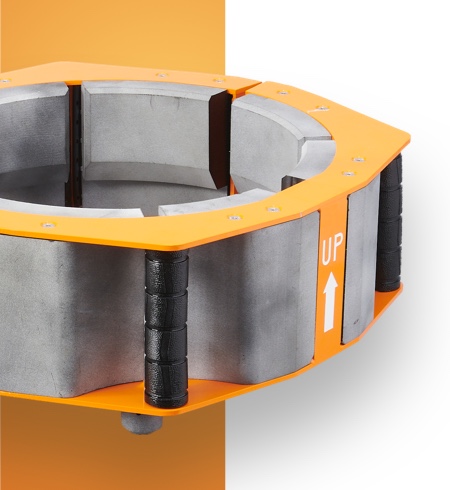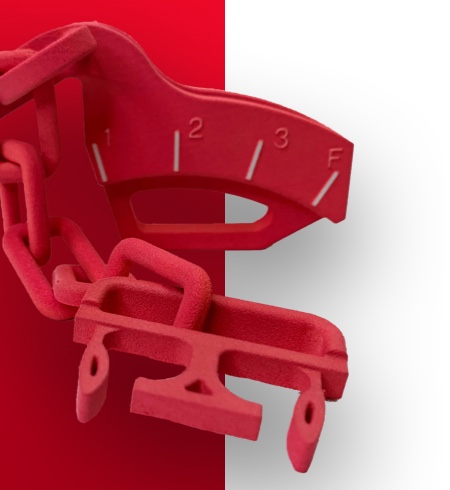Among the most exciting aspects of HP’s Multi Jet Fusion (MJF) technology when initially unveiled was the ability to 3D print functional objects in a full range of color. Though it took a couple of years for it to happen, that capability finally hit the market in 2018 with the release of the HP Jet Fusion 300/500 Color 3D Printer range. Now we are beginning to see the applications that a broad spectrum of hues has in practice. Airbus services company Satair used the technology to 3D print a series of tools for its maintenance operations.

Used to gag the main landing gears on the A380, the GAGS tool pads were redesigned to improve the strength-to-weight ratio, resulting in 60 percent mass reduction. Image courtesy of HP.
Satair turned to service bureau Fast Radius with the ultimate goal of to speed up aircraft repair with the use of 3D printed tools. As a member of HP’s Digital Manufacturing Network, Fast Radius leveraged MJF to print tools for the company. In particular, the color printing capabilities of the Jet Fusion 580 Color system were utilized to 3D print bright red and orange tools in order to improve job safety and ensure that tools were not misplaced after use. The tools were also optimized to reduce total part count, enhance robustness and integrate new functions.
One particularly unique feature about the company is the fact it has a production hub on-site at the UPS Worldport facility in Louisville, Kentucky, allowing it to potentially ship parts at greater speeds than other service providers.

This pintle bearing alignment tool is used to bear in the rear spar prior to installing it during the installation of the main landing gear installation. Assembly was reduced from four parts to two. Image courtesy of HP.
Three new tools were redesigned and printed by HP and Fast Radius for Satair: GAGS tool pads, pintle bearing alignment tools, and flap zero locking tools. MJF was chosen in part for the ability to 3D print durable parts with the mechanical properties necessary for harsh aircraft repair environments. Specifically, HP 3D High Reusability PA 12 was chosen due to its chemical resistance to oils, grease, aliphatic hydrocarbons and alkalies.
3D printing the parts also sped up design time, as multiple iterations could be produced at once within a single build. The use of color also allowed for the communication of information in unique ways, such as 3D printing part numbers, serial numbers and scannable QR codes directly onto the tool.
Whereas Satair previously waited weeks for new tools to be manufactured, this project saw Fast Radius print, inspect, package and ship two tools in less than 48 hours. This was enabled in part by Fast Radius’s logistics partnership with UPS, with which it sent the items from Chicago to Hamburg, Germany.

This flap zero locking tool is used to lock flaps in the A320 cockpit. The assembly was reduced from six parts to two and resulted in a lead time reduction of 50 percent. Image courtesy of HP.
The use of 3D printing by Satair is just another notch in Airbus’s belt, as the aerospace giant deploys AM all across its business to the point that it is probably not necessary to recount all of the ways it is being used, but we can highlight the myriad parts printed for the A350 XWB, as well as the work of Premium AEROTEC and APWorks.
As for Fast Radius, this is another interesting customer from the service bureau, which is fond of emerging AM technologies. For instance, the company also used Carbon’s Digital Light Synthesis to print parts for Steelcase’s office chair. Outside of 3D printing, Fast Radius offers a number of other manufacturing services, including CNC machining and injection molding. With the Fast Radius Virtual Warehouse, the company is hoping to implement the concept of digital inventory, in which digital files replace physical stock, with goods manufactured on-demand.
As with 3D printing itself, it will take some time for designers and engineers to fully grasp the potential of producing parts in full color. The ability to use bright pigments for safety purposes and to embed QR codes is just the beginning. HP previously demonstrated the use of colors to exhibit the level of wear on a part, so that, as it is worn down, it shows new colors that can be more easily quantified. Augmented reality applications could also be developed based on embedded symbols in a part. In the near future, we may see even more interesting uses of full color printing of end parts.
Subscribe to Our Email Newsletter
Stay up-to-date on all the latest news from the 3D printing industry and receive information and offers from third party vendors.
Print Services
Upload your 3D Models and get them printed quickly and efficiently.
You May Also Like
Nikon SLM Solutions Sells SLM 500 to Primary Weapon Systems to Expand Suppressor Production
Primary Weapons Systems (PWS) is a Boise, Idaho-based manufacturer of suppressors, firearms, and related components. A subsidiary of Vigilant Gear and a sister company to aftermarket Glock slide manufacturer Lone...
3DPOD 261: Tooling and Cooling for AM with Jason Murphy, NXC MFG
Jason Murphy´s NXC MFG (Next Chapter Manufacturing) is not a generalist service; instead, the company specializes in making tooling. Using LPBF and binder jet, the company produces some of the...
HP and Firestorm Labs Form Partnership to Use Multi Jet Fusion 3D Printers in Deployable Factories
HP Inc., maker of a range of additive manufacturing (AM) solutions including the Multi Jet Fusion (MJF) ecosystem, has announced a partnership with Firestorm Labs, a developer of containerized, deployable...
3D Printing News Briefs, July 2, 2025: Copper Alloys, Defense Manufacturing, & More
We’re starting off with metals in today’s 3D Printing News Briefs, as Farsoon has unveiled a large-scale AM solution for copper alloys, and Meltio used its wire-laser metal solution to...
































